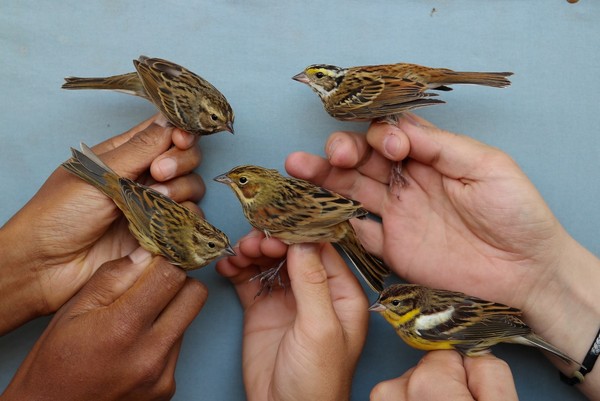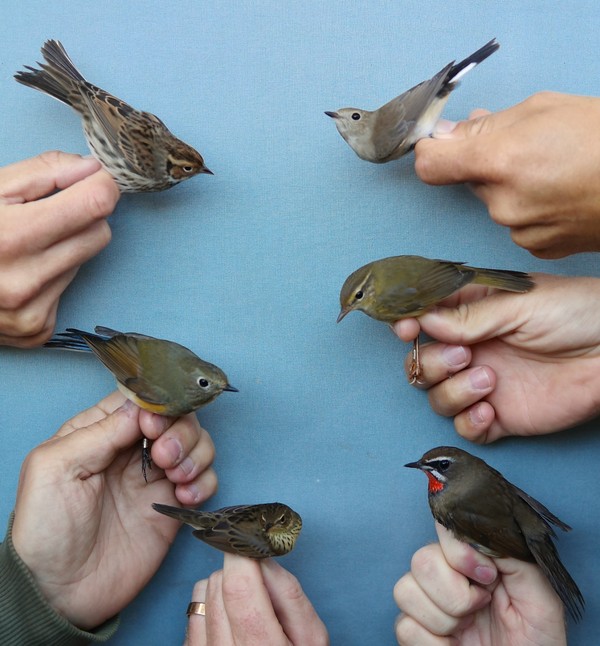September 2015- summery from Sami Timonen
Background
I was ringing birds at the Beidahe Banding Station (BBS) during a four-week period in 12 September - 9 October 2015. I had visited Beidahe already 23 years ago (in May 1992), at a time when ´western´ bird tourism was taking its first steps in the area. I had been ringing in Finland for a 10-year period with none ringing experience abroad.
Travelling
I took a daytime Finnair flight from Helsinki to Beijing. The flying time was 8,5 hours. At the airport Lao Zhang was welcoming me. He had arranged the train tickets and helped me to the train station, for a quick lunch etc. Travelling in a totally fully packed train went ok even though I was really exhausted for long travelling. At the Beidahe train station I met ringers Yang and Wang Jing Bo (aka Jack) who in the car introduced me right away to the recently caught Thick-billed Warblers (Acrocephalus aedon) and a Great Reed Warbler (Acrocephalus orientalis) (the last one was the only individual of the species I saw during my stay in Beidahe).
Weather
During my stay the prevailing winds were mainly weak or moderate. The afternoon temperatures were about 17 - 24 degrees. Only in one morning ringing was impossible due to rain and strong wind. In one night there was also very heavy thunder and pouring rain. In the last days of my period there were some fairly chilly nights with misty mornings.
Ringing
The number of used nets was altogether 38: 20 at the main ringing station, 8 at so called ´Corner Base´ and 10 at the Ricefields. The practical routines were: Yang ringed birds, I measured, aged and sexed them and Jack wrote all down to the record sheet. As I lived quite near the station I opened in many days part of the nets late in the evening ready for the morning.
During my ringing period we had altogether 27 active ringing days. The daily ringing numbers varied between 24-180 individuals. The total number of birds was 2415 individuals (average daily sum 89 individuals, excluding one rainy day). The total number of species was 61.
The ringing activities were for a Scandinavian ringer a really exciting experience. It was difficult to describe the feelings when in the first net rounds you did find at the same time Chestnut Bunting (Emberiza rutila), Pallas´s Grasshopper Warbler (Locustella certhiola) and Manchurian Bush Warbler (Locustella davidi) very close to each other… The most numerous species was, as expected, the Yellow-browed Warbler (Phylloscopus inornatus) with one third of all individuals ringed. The second place went to the Dusky Warbler (Phylloscopus fuscatus). These two species totalled altogether 45% of the whole number of ringed individuals. Most common birds were Dusky Warbler and Yellow-browed Warbler which were present at every day in the period. Other very common and frequent species were the Siberian Stonechat (Saxicola maurus), the Siberian Rubythroat (Luscinia calliope) and the Taiga Flycatcher (Ficedula albicilla). On the other hand we had 13 species (21 %) ringed in only one day and 12 species (20%) ringed in 2-3 days.
The ageing of ´eastern´ species was sometimes problematic, especially for several bunting species. The basic texts about ageing of buntings in Svensson´s guide and in the book ´Buntings and Sparrows´ (by Byers etc.) is difficult to put in practice when you do not have the experience the variation in characters etc. On the other hand, I found the sexing of Red-flanked Bluetails becoming soon clearer the more birds you were ringing (and with the aid of good identification article by Hellström & Norevik).
I was very pleased with the diversity of species. Only the eastern thrush species seen in the Beidahe area were mostly lacking but their migration period is mainly later in October. To me the highlights of the ringing period were e.g. the Pintail Snipe (Gallinago stenura), the Pechora Pipit (Anthus gustavi) and the Pine Bunting (Emberiza leucocephalos). With the help of Swedish group we investigated the ageing of Yellow-browed Warblers (color of rectrices, wingbar and iris). We got a nice direct comparison of two Bush Warbler species: the Baikal Bush Warbler (Locustella davidi) and the Chinese Bush Warbler (Locustella tacsanowskia). Björn Malmhagen was photographing Radde´s Warblers in order to find differences to the Yellow-streaked Warbler (Phylloscopus armandii). However, no Yellow-streaked´s were confirmed or suspected during the period.
Birding in the field
From the station we could see visible raptor migration with maximum numbers of few tens of individuals. The main species were Pied Harrier (Circus melanoleucos), Oriental Honey Buzzard (Pernis ptilorhynchos), Amur Falcon (Falco amurensis), European Sparrow Hawk (Accipiter nisus) and Japanese Sparrow Hawk (Accipiter gularis). Some White-throated Needletails (Hirundapus caudacutus) were also nice to see.
In the sandflats, on the estuary of River Xinhe, the birds were gathering in fairly good numbers. The Relict Gull was the most exotic species with maximum daily numbers of some tens of individuals. The most common and abundant wader species in the period were the Kentish Plover (Charadrius alexandrinus), the Great Knot (Calidris tenuirostris), the Far Eastern Curlew (Numenius madagascariensis), the Eurasian Curlew (Numenius arquata), the Bar-Tailed Godwit (Limosa lapponica) and on some days the Grey-headed Lapwing (Vanellus cinereus). With the Swedish group we birded also in the amusement park near Eagle Rock where there were nice scrub and bush areas. The gulls gathered quite close in the front of shore line.
Social contacts and leisure time
I noticed that China had changed quite a bit between my two visits! When in 1992 the local people just could not believe to see birders with scopes and bins, now there were tens of bird photographers around. In the bridge of the estuary there were almost every day a lot of Chinese with expensive optics. On the other hand, I did not see a single scope with the Chinese, so it seems that ´ordinary´ birdwatching is not as popular in China as photographing is.
Jack, Yang and I did not have to be alone with our ringing activities. The birds in Beidahe fulfilled my expectations but the ´social life´ went well above my expectations… The colour (and noise!) to the daily routines was brought by the participants of two workshops of National Bird Banding Centre (NBBC) from different regions in China. These people were going to be responsible persons for organising and participating ringing activities within their own organisations. Also the vice leader of NBBC and his family visited the station one day. A very nice addition to the visiting people was the Swedish Rarities Committee which came to Beidahe for one week. They visited the ringing station in the mornings and were birding elsewhere in the afternoon. Hasse (Hans Larsson) became famous at once when it was revealed that he is the artist behind the Rubythroat logo of Beidahe Banding Station. Apart from the Swedes the only birder I met was from Switzerland.
We had wonderful evening parties (barbeque) with Baijiu, toasts and excellent food at the hotel restaurant and elsewhere. The food in the staff restaurant of Safari Park was very basic. The tasty breakfast was brought to the ringing place by Jack or Yang (usually pies with various stuff inside). Alongside with the Swedish group came also toast songs were performed.
We had a tour in the Safari Park which is one of largest in China. The ringing station itself is situated in the grounds of Safari Park, and the ringers and station chief are all employees of Safari Park. The block of flats where I lived is a home for many Park workers. The family living next to me had Red Pandas as pets.
What comes to connections to homeland, I did not know that China blocks Gmail and many other western social media. It was lucky that Skype connection to Finland and Sweden worked OK.
Acknowledgements
All in all, I was very pleased with my stay in Beidahe and working at the Ringing Station. All the practical things worked finally out and they ran quite smoothly.
I warmly thank Bosse for all kindness and the info he gave me regarding travelling to China and how to live there for a longer period. And of course for letting me to stay in his rental house and using the electric mopeds. Tack för allt!
Many thanks go to Jack and Yang for their friendship and good co-operation in the field. I wish all the best to them in the future. Thanks to the Director of BBS, Mr. Lao Yang for letting me to participate to the work of ringing station. Thanks to Lao Zhang for practical help in Beijing. Of the other Chinese people I would like to thank Lianliang Yang from NBBC for getting me a good insight to Chinese way of thinking, habits etc.
Thanks to the members of Swedish Rarities Committee for their knowledge in birds and their great humour. Thanks also to Björn Malmhagen for letting me use his photos in this blog text.

Photo 1. Baikal Bush Warbler (Locustella davidi) (left) and Chinese Bush Warbler (Locustella tacsanowskia) in comparison. Photo: Björn Malmhagen

Photo 2. Beidahe is a heaven for Bunting watchers. From down left in clockwise direction: Chestnut Bunting (Emberiza rutila), Black-faced Bunting (Emberiza spodocephala), Yellow-browed Bunting (Emberiza chrysoprys), Chestnut-eared Bunting (Emberiza fucata) and Yellow-breasted Bunting (Emberiza aureola). Photo: Björn Malmhagen

Photo 3. ´Megamix´ of typical passerines in Beidahe. From down left in clockwise direction: Lanceolated Warbler (Locustella lanceolata), Red-flanked Bluetail (Tarsiger cyanurus), Little Bunting (Emberiza pusilla), Taiga Flycatcher (Ficedula albicilla), Radde´s Warbler (Phylloscopus schwarzi) and Siberian Rubythroat (Luscinia calliope). Photo: Björn Malmhagen

Great post. I was checking continuously this blog and I am inspired!
Extremely helpful information specially the last phase :) I
deal with such info much. I used to be looking for this particular information for a very lengthy time.
Thank you and best of luck.
Spot on with this write-up, I absolutely feel this amazing site needs much more attention. I'll probably be back
again to read more, thanks for the advice!
handwritten books were made,

